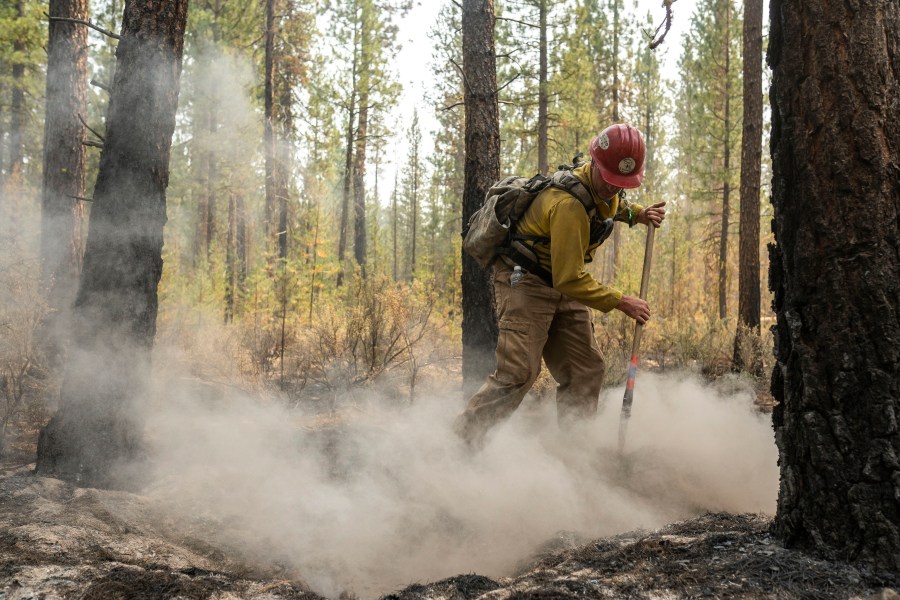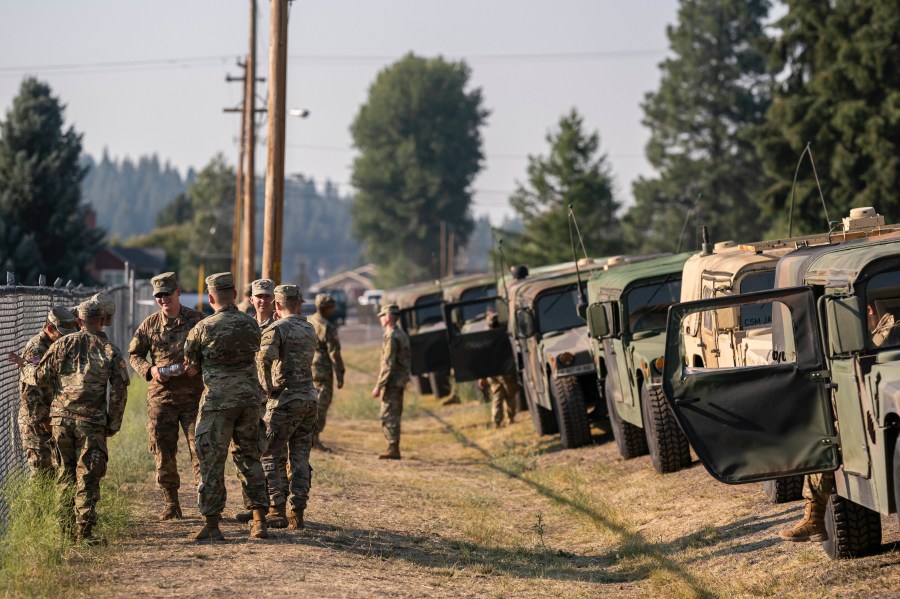PORTLAND, Ore. (AP) — More people living along the eastern edge of an Oregon wildfire were told to evacuate late Thursday as the inferno once more began spreading rapidly and erratically in hot afternoon winds and a nearby, smaller fire gained a foothold.
The Bootleg Fire, the largest wildfire currently burning in the U.S., has now torched an area larger than New York City and has stymied firefighters with erratic winds and extremely dangerous fire behavior. Some of the evacuations were triggered by a second, smaller fire called the Log Fire to the northeast of the main blaze that expanded to 500 acres in the past 24 hours.
The main fire has destroyed 21 homes in an area north of the Oregon-California border that’s been gripped by extreme drought. It was 7% contained as of Thursday, when authorities decided to expand previous evacuation orders near Summer Lake and Paisley. Both towns are located in Lake County, a remote area of lakes and wildlife refuges with a total population of about 8,000.

“We’re trying to determine where is it moving, how far and how fast, to determine what to do with evacuation levels,” said Gert Zoutendijk, spokesman for the Oregon office of the State Fire Marshal. “The big word is for everyone in Lake County to be aware and start getting signed up for the alert system if they have not already.”
On Wednesday, the Bootleg Fire generated enormous smoke columns that could be seen for miles — a sign that the blaze is so intense it is creating its own weather, with erratic winds and the potential for fire-generated lightning.
Meanwhile, a fire near the northern California town of Paradise, which burned in a horrific 2018 wildfire, caused jitters among homeowners who were just starting to return to normal after surviving the deadliest blaze in U.S. history.
Chuck Dee and his wife, Janie, returned last year to Paradise on the foothills of California’s Sierra Nevada to rebuild a home lost in that fire. So when they woke up Thursday and saw smoke from the new Dixie Fire, it was frightening, even though it was burning away from populated areas.
“It made my wife and I both nervous,” he told The Associated Press in a telephone interview.
The Dixie Fire was tiny when it began on Tuesday, but by Thursday morning it had burned 3.5 square miles of brush and timber near the Feather River Canyon area of Butte County northeast of Paradise. It also moved into national forest land in neighboring Plumas County.
There was zero containment and officials kept in place a warning for residents of the tiny communities of Pulga and east Concow to be ready to leave.
The Dixie Fire is part of a siege of conflagrations across the West. There were 71 active large fires and complexes of multiple fires that have burned nearly 1,553 square miles in the U.S., mostly in Western states, according to the National Interagency Fire Center.

Extremely dry conditions and heat waves tied to climate change have swept the region, making wildfires harder to fight. Climate change has made the American West much warmer and drier in the past 30 years and will continue to make weather more extreme and wildfires more frequent and destructive.
In the Pacific Northwest, firefighters say they are facing conditions more typical of late summer or fall than early July.
A wildfire threatening more than 1,500 homes near Wenatchee, Washington, grew to 14 square miles by Thursday morning and was about 10% contained, the Washington state Department of Natural Resources said.
About 200 firefighters were battling the Red Apple Fire near the north-central Washington city renowned for its apples. The fire was also threatening apple orchards and an electrical substation, but no structures have been lost, officials said.
In Paradise, California, about 80 miles north of Sacramento, residents are focused on rebuilding. So far, 1,642 building permits have been issued with 923 homes completed, according to the city’s website. The skyrocketing cost of lumber has complicated some projects, but Dee said he was fortunate to get his bid in place before the prices rose.
The Dees’ rebuilt house is a little smaller than the original one, and with a different floor plan — and this one was constructed with fire retardant siding. A local law also prohibits wooden fences from touching the houses.
The couple hope to move in once they get their utilities hooked up. In the meantime, they’re living in an RV. They said they don’t regret moving back, having accepted that fires will be part of life in this part of California.
“We can’t wait to get back in this house and get started,” Chuck Dee said.
Latest News
- AUTO TEST: Blocks – Checking Link Group Sharing block
- AUTO TEST POST 20241212231237
- AUTO TEST POST 20241212231151
- AUTO TEST POST 20241212230901
- AUTO TEST POST 20241212200036






